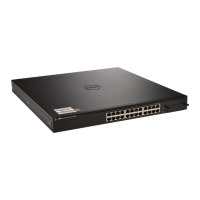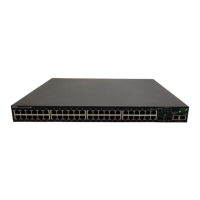Managing QSFP Ports 141
8
Managing QSFP Ports
QSFP ports can operate in 1 x 40G mode or in 4 x 10G mode. Appropriate
cables must be used that match the selected mode. When changing from one
mode to another, a switch reboot is required. The QSFP ports also support
stacking over the interfaces in either 1 x 40G or 4 x 10G mode. Changing
from Ethernet mode to stacking mode and vice-versa requires a reboot as
well.
The ports on a QSFP plugin module are named Fo1/1/1-2 in 40-gigabit mode
and Te1/1/1-8 in 10-gigabit mode. On the PC8164, the fixed QSFP ports are
named Fo1/0/1-2 in 40-gigabit mode and Te1/0/49-56 in 10-gigabit mode. All
of the possible populated or configured interfaces will show in the show
interfaces status command regardless of the port mode, i.e. 40-gigabit or
10-gigabit. Unpopulated or unconfigured interfaces for plug in modules do
not show in the show interfaces status command.
The default setting for a 40-gigabit Ethernet interface is nonstacking,
40-gigabit Ethernet (1 x 40G).
The commands to change 1 x 40G and 4 x 10G modes are always entered on
the 40-gigabit interfaces.
The commands to change the Ethernet/stack mode are entered on the
appropriate interface (tengigabitethernet or fortygigabitethernet). It is
possible to configure some of the 10G ports in a 40G interface as stacking and
not others.
To reconfigure a QSFP port, select the 40-gigabit port to change in Interface
Config mode and enter the hardware profile portmode command
with the selected mode. For example, to change a 1 x 40G port to 4 x 10G
mode, enter the following commands on the forty-gigabit interface:
console(config)#interface fo1/1/1
console(config-if-Fo1/1/2)#hardware profile portmode 4x10g
This command will not take effect until the switch is rebooted.
console(config-if-Fo1/1/2)#do reload
Are you sure you want to reload the stack? (y/n)

